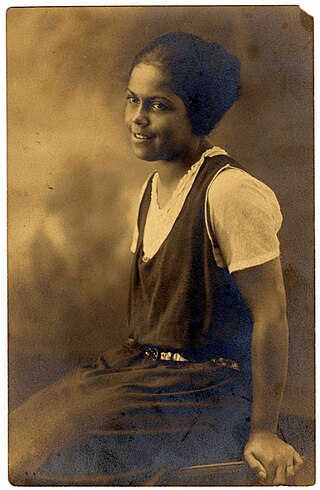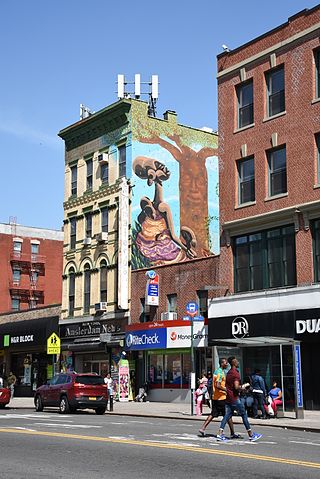
The Black Arts Movement (BAM) was an African American-led art movement that was active during the 1960s and 1970s. Through activism and art, BAM created new cultural institutions and conveyed a message of black pride. The movement expanded from the incredible accomplishments of artists of the Harlem Renaissance.
John Henrik Clarke was an African-American historian, professor, prominent Afrocentrist, and pioneer in the creation of Pan-African and Africana studies and professional institutions in academia starting in the late 1960s.

Gwendolyn B. Bennett was an American artist, writer, and journalist who contributed to Opportunity: A Journal of Negro Life, which chronicled cultural advancements during the Harlem Renaissance. Though often overlooked, she herself made considerable accomplishments in art, poetry, and prose. She is perhaps best known for her short story "Wedding Day", which was published in the magazine Fire!! and explores how gender, race, and class dynamics shape an interracial relationship. Bennett was a dedicated and self-preserving woman, respectfully known for being a strong influencer of African-American women rights during the Harlem Renaissance. Throughout her dedication and perseverance, Bennett raised the bar when it came to women's literature and education. One of her contributions to the Harlem Renaissance was her literary acclaimed short novel Poets Evening; it helped the understanding within the African-American communities, resulting in many African Americans coming to terms with identifying and accepting themselves.

Dorothy West was an American novelist short-story writer, and magazine editor associated with the Harlem Renaissance, a cultural movement in the 1920s and 1930s that celebrated black art, literature, and music. She was one of the few Black women writers to be published in major literary magazines in the 1930s and 1940s. She is best known for her 1948 novel The Living Is Easy, about the life of an upper-class black family and their attempts to climb the social ladder. She also explored the complexities of the black experience in the United States in short stories and essays that challenged stereotypes and explored themes such as race, class, and gender. Her work paved the way for future generations of African-American writers, and her legacy continues to inspire and influence writers today.

The Schomburg Center for Research in Black Culture is a research library of the New York Public Library (NYPL) and an archive repository for information on people of African descent worldwide. Located at 515 Malcolm X Boulevard between West 135th and 136th Streets in the Harlem neighborhood of Manhattan, New York City, it has, almost from its inception, been an integral part of the Harlem community. It is named for Afro-Puerto Rican scholar Arturo Alfonso Schomburg.

The Amsterdam News is a weekly Black-owned newspaper serving New York City. It is one of the oldest newspapers geared toward African Americans in the United States and has published columns by such figures as W. E. B. Du Bois, Roy Wilkins, and Adam Clayton Powell Jr., and was the first to recognize and publish Malcolm X. It operated from the New York Amsterdam News Building on Seventh Avenue in Harlem from 1916-1938. The building is a National Landmark.
Lonne Elder III was an American actor, playwright and screenwriter. Elder was one of the leading African-American figures who informed the New York theater world with social and political consciousness. He also wrote scripts for television and film. His best known play, Ceremonies in Dark Old Men, won him a Drama Desk Award for Most Promising Playwright and was nominated for the Pulitzer Prize. The play, which was about a Harlem barber and his family, was produced by the Negro Ensemble Company in 1969.

Rosa Cuthbert Guy was a Trinidad-born American writer who grew up in the New York metropolitan area. Her family had immigrated and she was orphaned when young. Raised in foster homes, she later was acclaimed for her books of fiction for adults and young people that stressed supportive relationships.

John Oliver Killens was an American fiction writer from Georgia. His novels featured elements of African-American life. In his debut novel, Youngblood (1954), Killens coined the phrase "kicking ass and taking names". He also wrote plays, short stories and essays, and published articles in a range of outlets.
Keith Gilyard is a writer and American professor of English and African American Studies. He has passionately embraced African American expressive culture over the course of his career as a poet, scholar, and educator. Beyond his own literary output, he has pursued – and in some instances merged - two main lines of humanistic inquiry: literary studies, with its concern for beauty and significant form, and rhetorical studies, with its emphasis on the effect of trope and argument in culture. Moreover, his interests branch out into popular culture, civic discourse, and educational praxis. A critical perspective concerning these areas is, in his view, integral to the development of discerning and productive publics both on and beyond campuses and therefore crucial to the optimal practice of democracy.
The National Black Writers Conference (NBWC) is presented by the Center for Black Literature (CBL) at Medgar Evers College of The City University of New York. Founded by Dr. Brenda M. Greene, the Center for Black Literature was officially approved by the College Council of Medgar Evers College and by the board of trustees in October 2002. Its mission is to expand, broaden, and enrich the public's knowledge and aesthetic appreciation of literature produced by people of the African diaspora. It accomplishes its mission through a variety of programs and partnerships and by serving as a forum for the discussion, reading, research, study, and critical analysis of Black literature. It is the only center devoted to this mission in the country.
John Glover Jackson was an American Pan-Africanist historian, lecturer, teacher and writer. He promoted ideas of Afrocentrism, atheism, and Jesus Christ in comparative mythology.
African Americansin France are people of African heritage or black people from the United States who are or have become residents or citizens of France. This includes students and temporary workers.
Sarah Elizabeth Wright was an American writer and social activist. Her novel This Child's Gonna Live, published in 1969, was acclaimed by critics and "was among the first to focus on the confluence of race, class and sex". The New York Times named it "outstanding book of 1969" and it was called a "small masterpiece".
Calvin L. Hicks was an African-American journalist, activist, editor, and music educator. He died in New York.
Freedomways was the leading African-American theoretical, political and cultural journal of the 1960s–1980s. It began publishing in 1961 and ceased in 1985.

Louise Meriwether was an American novelist, essayist, journalist and activist, as well as a writer of biographies of historically important African Americans for children. She is best known for her first novel, Daddy Was a Number Runner (1970), which draws on autobiographical elements about growing up in Harlem, New York City, during the Depression and in the era after the Harlem Renaissance.
Arthur R. Flowers, Jr. is an American novelist, memoirist, and performance poet. His work is known for its focus on the African-American experience, particularly folklore, blues music, and hoodoo spiritualism.








